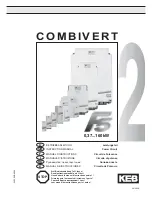
Proper Operation
HYUNDAI INVERTER
–
Before use, be sure to read through the Instruction Manual to insure proper operation.
–
Note that the inverter requires proper electrical wiring; a specialist should carry out the wiring.
–
The inverter in this catalog is designed for general industrial applications. For special applications in fields such as aircraft, outer
space, nuclear power, electrical power, transport vehicles, clinics, and submarine relay equipment, please consult us in advance.
–
For application in a facility where human safety is at stake or serious losses may occur, be sure to program all safety devices to
avoid serious accidents.
–
The inverter is used for three-phase AC motor.
Operating
frequency
Torque
characteristics
Motor loss & temp-
erature increase
Noise
Vibration
Power
transmission
mechanism
The overspeed endurance of a general-purpose motor is 120% of the rated speed for 2 minutes (JIS C4004). For operation higher than 60 Hz,
it is required to examine the allowable torque of the motor, useful-life of bearings, noise, vibration, etc.
In this case, be sure to consult the motor manufacturer as the maximum allowable rpm differs depending on the motor capacity, etc.
The torque characteristics of driving a general-purpose motor with an inverter differ from those of driving it with commercial power
(starting torque decreases in particular). Carefully check the load torque characteristic of a connected machine and the driving torque
characteristic of the motor.
An inverter-driven general-purpose motor heats up swiftly at lower speeds. Consequently, the torque level permitting continuous use
decreases with lower motor speeds. Carefully check the torque characteristics.
When run by an inverter, a general-purpose motor generates noise slightly greater than with commercial power.
When run by an inverter at variable speeds, the motor may regenerate vibration, especially because of (a) unbalanced rotor including
a connected machine, or (b) resonance caused by the natural vibration frequency of a mechanical system.
Particularly, be careful of (b) when operating a machine previously fitted with a constant speed motor at variable speed.
Vibration can be minimized by (1) avoiding resonance points using the frequency jump function of the inverter,
(2) using a flexible coupling, or (3) placing a rubber shock absorber beneath the motor base.
Under continuous, low-speed operation, oil lubrication can deteriorate in a power transmission mechanism with an oil-type gear box
(gear motor) or reducer. Consult the motor manufacturer for the permissible range of continuous speed.
To operate at more than 60 Hz, confirm the machine's ability to withstand the centrifugal force generated.
Application to General-Purpose Motors
Run or stop of the inverter must be done with the keys on the operator panel or through a control circuit terminal.
Do not operate by installing a electromagnetic contactor (M) in the main circuit.
When the protective function is operating or the power supply stops, the motor enters the free run stop state.
When an emergency stop is required or when the motor should be kept stopped, use the mechanical brake.
A max. of 360 Hz can be selected on the N50 Series. However, a two-pole motor can attain up to approx. 21,600 rpm,
which is extremely dangerous.
Therefore, carefully make selection and settings by checking the mechanical strength of the motor and connected machines.
Consult the motor manufacturer when it is necessary to drive a standard (general-purpose) motor at over 60 Hz. A full line of
high-speed motors is available from manufacturer.
Run/Stop
Emergency
motor stop
Notes on Use: Drive
High-frequency
run
Gear motor
The allowable rotation range of continuous drive varies depending on the lubrication method or motor manufacturer. (Particularly where
oil lubrication is concerned, pay attention to the low frequency range). The Hitachi GA/GX/CX gear motors are of a grease lubrication
type. Their grease lubrication capability remains unchanged even if the motor rotating speed decreases.
When using a brake motor, be sure to connect the braking power supply on the primary side of the inverter.
Brake motor
Inverter drive is not suitable for a safety-enhanced explosion-proof type of motor.
The inverter should be used in combination with a pressure-proof and explosion-proof type of motor.
※
Explosion-proof verification is not available for N100 Series. For explosion-proof operation, use an other series of motors.
Explosion-
proof motor
In most cases,the synchronous (MS) motor and the high-speed (HFM)
motor are designed and manufactured to meet the specifications suitable
for a connected machine. Consult us to select an inverter.
Synchronous (MS) motor
High-speed (HFM) motor
Single-phase
motor
Application to Special Motors
A single-phase motor is not suitable for
variable-speed operation by inverter drive.
Therefore, use a three-phase motor.
Summary of Contents for HiRun N50 Series
Page 1: ......



































